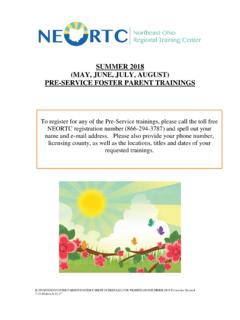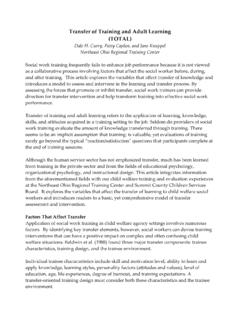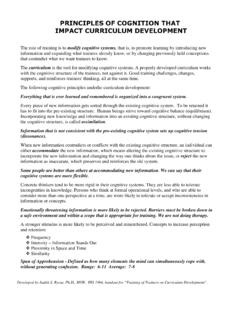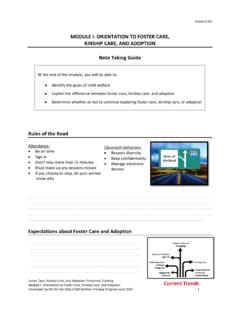Transcription of Second Edition A Guide for Foster Care and ... - …
1 Second Edition A Guide for Foster care and Adoption Assessors Use of the Family Interview Guide This Guide will provide sample questions to help you conduct your interviews with prospective adoptive parents and Foster caregivers. It is also appropriate to use in assessing kinship care families in becoming licensed Foster caregivers. These sample questions are only offered as suggested guidelines. Of course, interview questions will need to be tailored to the families being interviewed, and follow-up questions will need to be formulated based on responses from the family members. These questions will give Assessors a starting point as they gather assessment data and Guide the family through a process of self-assessment in the Foster care and adoption application process. Developed by the Institute for Human Services for the Ohio Child Welfare Training Program 2015.
2 Material in this Guide has been adapted from the following sources: The Field Guide to Child Welfare, Vol II, Case Planning and Family-Centered Casework, and Vol. IV, Placement and Permanence by J. Rycus and R. Hughes (Child Welfare League of America Press, 1998). Family and Child Assessment, Tier I Assessor Curriculum, Ohio Child Welfare Training Program, revised 2015. Foster care , Kinship care , and Adoption Preservice Training, Ohio Child Welfare Training Program, revised 2015. Promoting Normalcy for Children and Youth in Foster care . Juvenile Law Center 2015. 2. I. WHAT IS A FAMILY ASSESSMENT? The purpose of the family assessment, also known as the Homestudy, is for the Assessor and the applicant to mutually determine the appropriateness and readiness of the family for Foster care or adoption.
3 The goals of the family assessment are to: 1) Educate the family about the differences between Foster care and adoption 2) Help the family explore their values, expectations, and motivations 3) Help the family identify and highlight their strengths and limitations 4) Provide the Assessor with the opportunity to determine if the applicants have experienced trauma in their life and what is the potential impact of that trauma on their ability to be Foster caregivers or adoptive parents 5) Provide the family with the agency's philosophy and values regarding Foster care and adoption 6) Prepare the family for the challenges of adoption or caregiving 7) Initiate the self-selection process for the applicant 8) Develop a working relationship between the family and the Assessor as well as between the family and the agency Agencies use a variety of assessment opportunities including: 1) Individual and family interviews 2) Observation of the applicant at Preservice training and other group sessions 3) Criminal record checks and personal and employment references which may include credit reports and physical and mental health evaluations 4) The Assessor's own experience with the family 5) Statewide Automated Child Welfare Information System (SACWIS).
4 Database searches II. HOW DOES DIVERSITY IMPACT THE. ASSESSMENT PROCESS? Diversity refers to all the characteristics that distinguish one person from another. Diversity competence is: 1) The capacity to relate to persons with diverse characteristics in a sensitive, respectful, and productive way. 3. 2) An ongoing developmental process that includes: An acquired understanding of the patterns and potential dynamics of diverse groups and cultures, including our own The understanding of how culture (the values, beliefs, attitudes, and traditions acquired from affiliate groups), and other circumstances influence our own and other people's thinking and behaviors The ability to manage and adapt to the dynamics of difference, and work effectively with all people Diversity competence impacts: 1) The quality of assessment and supportive services provided to Foster and kinship caregivers and adoptive families, and 2) Decisions made by Assessors placing children in Foster or adoptive homes.
5 Sound Foster care and adoption practice begins with a commitment from the Assessor to provide diversity-competent services. To succeed, Assessors need: 1) An awareness and acceptance of diversity and differences 2) An awareness of their own values 3) An understanding of the dynamics of difference in the helping process 4) A basic knowledge about the applicants' diversity 5) Knowledge of the applicants' environment 6) The ability to adapt practice skills to fit the applicants' context Assessors will serve clients from vastly different backgrounds than their own. While it may be easy to dismiss another's diversity as wrong or inappropriate, the Assessor must provide non-discriminatory and competent services to each family and child on his or her caseload. Skills in relationship-building and communication are essential during the interview process and greatly enhance the quality of the mutual assessment.
6 Prospective families and caregivers should be assessed within the context of their own diversity. To reduce the chance of an inaccurate assessment, Assessors must consider different communication and interaction styles, nonverbal behaviors, differences in the use and meaning of specific words and phrases, family roles and relationships, and home environments. 4. III. ENGAGING THE FAMILY IN ASSESSMENT. A critical first step in family assessment is engagement, a process of putting the family at ease, drawing its members more comfortably into the process, and building trust and rapport. Successful engagement increases the likelihood of a more effective assessment outcome. Some strategies to successfully engage Foster and adoptive applicants include: Respect the family's diversity Establish a clear purpose for each interview Determine where the family feels most comfortable in holding interviews Determine how the applicants prefer to be addressed Ask open-ended questions that are general in nature to allow applicants an opportunity to express themselves Display a non-judgmental attitude Vary the intensity of the interview so that there is a balance between more probing, personal questions and more superficial ones Seek opportunities to compliment the family about their children, home, activities, etc.
7 Acknowledge the family pet(s). Be sure to answer the family's questions and address their concerns during each contact IV. INTERVIEWING METHODS. An Assessor should make an effort to ask behavioral rather than theoretical questions. Theoretical questions typically elicit responses the applicant feels the Assessor wants to hear, and these questions provide relatively limited insight into the applicant's strengths or challenges. Behavioral questions, on the other hand, focus on actual events in the applicant's history. They are founded on the understanding that an excellent predictor of future behavior is past behavior. Asking applicants how they have handled similar situations in the past will give the Assessor (and the applicants) a much clearer picture of their readiness for adoption or Foster care .
8 The Assessor must develop diverse, effective, and efficient verbal, non- verbal and observational skills and should utilize a variety of interviewing techniques. See opposite page 5. Interviewing Method Description Examples Closed-ended, probing or Allows Assessor to gather specific What is your birth date? . yes/no questions information from applicants How long have you been married? Divorced ? How old are your children? . Open-ended questions Assists Assessor in gathering a Tell me about your broad range of information childhood? . including insight into applicants' Describe your spouse to me.. feelings and perceptions Why are you interested in this type of child? . Supportive responses - Builds trust between Assessor and It must be difficult to accept Active listening applicants; Encourages applicants that you cannot have children to be honest in the interview biologically.
9 Sounds like you have thought about adopting or caregiving for a very long time.. Clarification Helps Assessor accurately You believe that you have a interpret applicants' responses; good marriage; What does Assist applicants in gaining insight that mean? Sounds like you into their own feelings and are feeling very ambivalent perceptions about a school-age child. Can you tell me more about that ? Summarization- Helps to maintain focus and Now that you've talked about Redirection organization during interview; your childhood, let's hear Assists Assessor in moving about your life as a married interview along and using limited person. (redirection) You've time efficiently told me three things that you consider strengths: your parenting experience, high energy level, and positive relationship with the school system.
10 (summarization). Giving options, advice or Allows Assessor to serve in a I can see that your heart's set suggestions supportive role to applicants on adopting a newborn. Our agency only places older children with special needs. Let me give you the names and numbers of agencies who can help you.. Confrontation Necessary when Assessor feels I don't believe that you are applicants have been resistant or giving me all the details about have not been completely honest the extent of the abuse you in responses suffered as a child.. 6. V. TWELVE ASSESSMENT CATEGORIES. 1) Attitudes and beliefs regarding Foster care and adoption issues . the applicants' ability to view themselves as resource families for children who enter their home, and as team members rather than consumers of services.
















